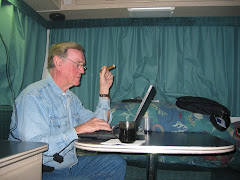 The hospital tried to stay alive by asking people to get "Crook" sick in Cook
The hospital tried to stay alive by asking people to get "Crook" sick in Cook In its "heyday" it cost $3 to play the nine holes. In 100 plus degrees?
In its "heyday" it cost $3 to play the nine holes. In 100 plus degrees?After travelling all night from Adelaide we were awakened at 7am in time to prepare for entering the metropolis of Cook; population two. Cook was a town of 300 as recently as 1998; its sole purpose to service the National Railroad. The town boasts a school, swimming pool, hospital, post office and railroad service yards. It even has a golf course without a single blade of grass; a true links course with packed sand greens. The hospital had so little business that amid concerns about being closed by the government, people stopping over on the railroad were encouraged to "...get crook on Cook." (Crook being 'strine for sick).
When the government decided to get out of the railroad business in the '90s, privatizing its interests, Cook became an instant ghost town -an example of how changing government policy can have trickle down consequences.
Today Crook is used only as a changeover point for locomotive drivers, and a refueling stop after a long night run- just before the train starts to cross the Nullibor. This is the only reason we had a chance to stretch our legs. There's no platform, and steps have been placed at the exit doors. The conductor gives us all a stern warning not to cross the tracks, as passing trains in other directions likely will not slow down.. And above all be ready to board when the whistle blows- there are no overnight accommodations in Cook. Not a more desolate railroad stop in the world, with summertime temperatures about 155 degree, and a single digit of annual rainfall. We tried to find some remains of the golf course, but the site could not be distinguished, nature having taken it back. In a few more years there will be little left of this lonely reminder of times past.


